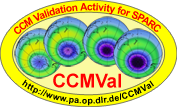Dataset
CCMVal-1: University of Leeds UMSLIMCAT model output contribution to the WMO 2006 REF2 experiment
Abstract
CCMVal was a large international effort to improve understanding of Chemistry-Climate Models (CCMs) and their underlying GCMs (General Circulation Models) through process-oriented evaluation, along with discussion and coordinated analysis of science results. The first round of CCMVal (CCMVal-1) evaluated only a limited set of key processes in the CCMs, focusing mainly on dynamics and transport.
This dataset contains UMSLIMCAT model output from the WMO 2006 REF2 experiment run by the University of Leeds.
Details
| Previous Info: |
No news update for this record
|
|---|---|
| Previously used record identifiers: |
http://badc.nerc.ac.uk/view/badc.nerc.ac.uk__ATOM__ACTIVITY_8021c3b6-26e6-11e4-b505-00163e251233
|
| Access rules: |
Access to these data is available to any registered CEDA user. Please Login or Register for a CEDA account to gain access.
Use of these data is covered by the following licence(s): http://creativecommons.org/licenses/by/4.0/ When using these data you must cite them correctly using the citation given on the CEDA Data Catalogue record. |
| Data lineage: |
CCMVAL-1 data were converted from original model format to ASCII by the modelling teams. |
| File Format: |
Data are ASCII formatted
|
Related Documents
| UMSLIMCAT webpage |
| Participating CCMs and Model PIs |
Process overview
| Title | SLIMCAT model deployed on Leeds computer |
| Abstract | SLIMCAT model deployed on Leeds computer. SLIMCAT was a three-dimensional (3D) off-line chemical transport model (CTM). The model used winds and temperatures from meteorological analyses (e.g. from the UK Met Office or ECMWF) to specify the atmospheric transport and temperatures and calculates the abundances of chemical species in the troposphere and stratosphere. The model had the option of detailed chemical scheme(s) for the stratosphere and troposphere. The model can be used to simulate the past and current atmosphere, help interpret observations, and to diagnose the extent of problems such as stratospheric ozone depletion or tropospheric pollution. This model was developed at the University of Leeds, UK. == Introduction == Around 1995 Martyn Chipperfield (University of Leeds) wrote SLIMCAT. This was a stratosphere-only version of TOMCAT formulated on isentropic levels. At this time TOMCAT became a 'tropospheric' model and various people in Cambridge helped to add treatments of e.g. convection, boundary layer mixing, and tropospheric chemistry. Recently, SLIMCAT has been extended downwards to include the troposphere. As the two former models were so similar, it made maintenance/development easier to merge TOMCAT and SLIMCAT into a single library with a choice of vertical coordinate (and other things), so that one model covers all of the applications. Depending on the coordinate use, the model is still referred to as TOMCAT or SLIMCAT. === Key Details === - Variable resolution. Typical resolutions are 5 x 5 degrees for multiannual runs to up to 1 x 1 degree. |
| Input Description | None |
| Output Description | None |
| Software Reference | None |
No variables found.
Temporal Range
1980-01-01T00:00:00
2020-12-31T23:59:59
Geographic Extent
90.0000° |
||
-180.0000° |
180.0000° |
|
-90.0000° |

